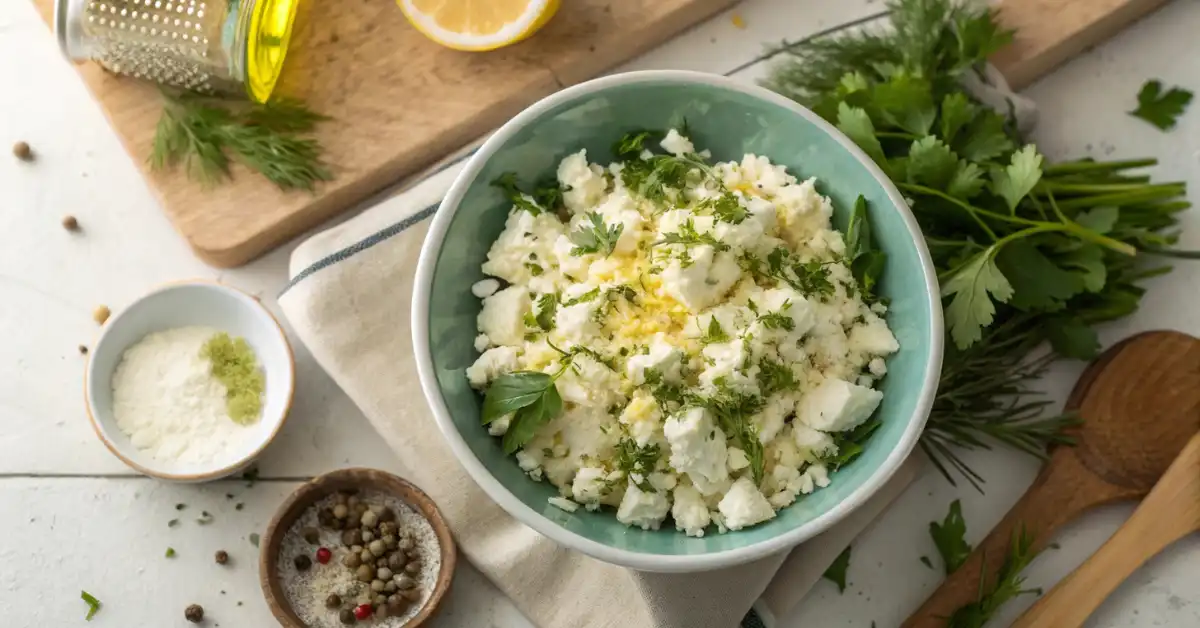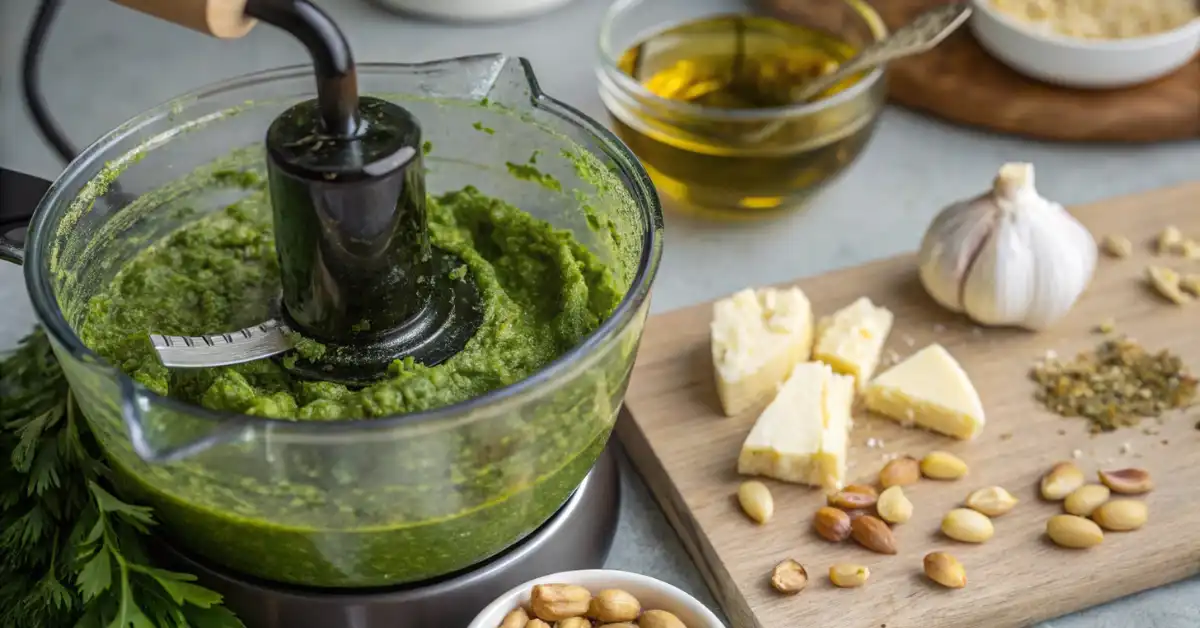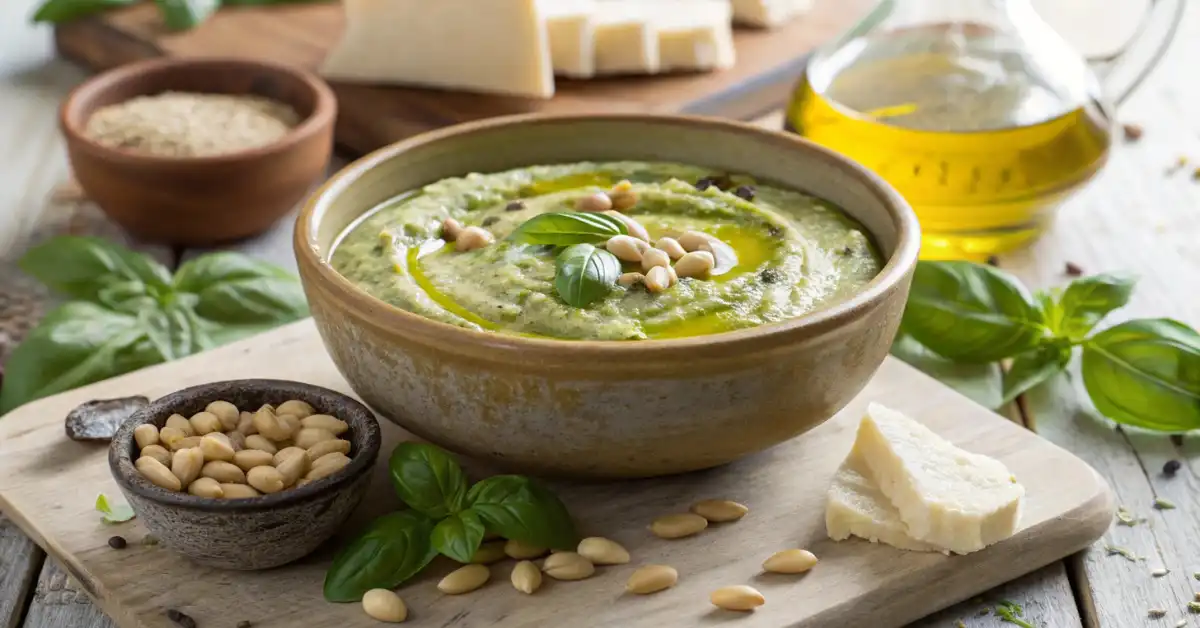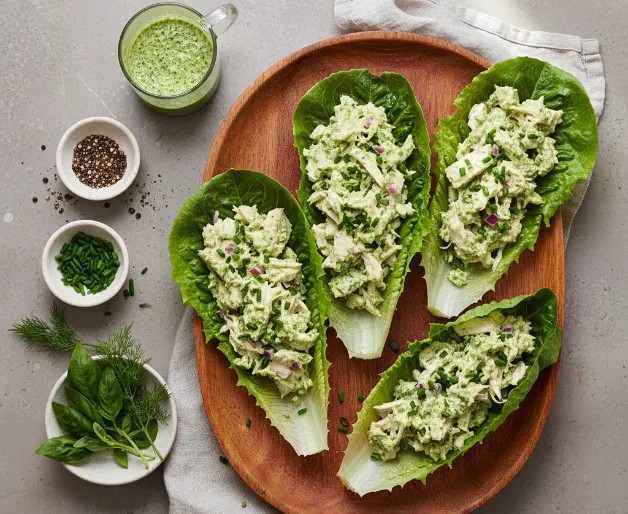A Mediterranean Discovery
It all started in a small sun-drenched kitchen on the Greek coast, where herbs danced in the breeze and feta sat crumbled beside olive oil jars. I had just run out of Parmesan, and my pasta water was already boiling. In a rush of improvisation, I tossed feta into my mortar with fresh basil, garlic, and pine nuts. The result? A rich, creamy sauce that was tangy, salty, and wildly aromatic—something so satisfying that I never looked back. That was my first taste of feta pesto, and it unlocked a whole new way of thinking about this classic Mediterranean condiment.
In this article, we’ll dive into everything there is to know about feta pesto—from its flavor-packed appeal and simple preparation to creative serving ideas and storage hacks. Whether you’re a pesto purist or a feta fanatic, you’re about to fall in love with this bold, creamy twist on tradition.
Check out our Watermelon Feta Pasta Salad for another exciting use of feta cheese.
Table of Contents
Table of Contents

Feta Pesto – A Creamy Twist on the Classic Mediterranean Sauce
- Total Time: 10 minutes
- Yield: Sauces & Dips
Description
A bold, creamy twist on the classic pesto recipe. This Mediterranean-inspired feta pesto blends fresh herbs, garlic, and tangy feta into a rich, spreadable sauce perfect for pasta, sandwiches, and more.
Ingredients
Ingredients
- 1 cup fresh basil leaves (packed)
- ½ cup feta cheese, crumbled
- ¼ cup pine nuts (or walnuts)
- 1 garlic clove, peeled
- Juice of ½ lemon
- ⅓ cup extra virgin olive oil
- Salt and black pepper to taste
Instructions
Step by Step
- In a food processor, blend basil, garlic, and pine nuts until finely chopped.
- Add crumbled feta and lemon juice.
- With the processor running, slowly drizzle in olive oil until smooth and creamy.
- Taste and season with salt and pepper as needed.
- Serve immediately or store in an airtight jar in the fridge.
Notes
- For a milder garlic taste, roast the garlic before blending.
- To make it vegan, substitute with plant-based feta.
- Add a spoonful of Greek yogurt for extra creaminess.
- Store in an airtight container for up to 5–7 days in the fridge.
- Freeze in cubes and thaw as needed.
- Prep Time: 10 minutes
- Cook Time: 0 minutes
- Category: Sauces & Dips
- Method: Blending (No-cook)
- Cuisine: Mediterranean / Greek Fusion
Nutrition
- Serving Size: 2 tablespoons (1/8th of recipe)
- Calories: 135 kcal
- Sugar: 0.3 g
- Sodium: 290 mg
- Fat: 13 g
- Saturated Fat: 3.5 g
- Unsaturated Fat: 8.5 g
- Trans Fat: 0 g
- Carbohydrates: 1.8 g
- Fiber: 0.5 g
- Protein: 3 g
- Cholesterol: 12 mg
Discover the Revolutionary Feta Pesto That’s Taking Kitchens by Storm
Understanding Classic Pesto Makes This Meal Even More Spectacular
To understand what makes feta pesto unique, let’s start with its roots. Traditional pesto—originating from Genoa, Italy—is a blend of fresh basil, pine nuts, garlic, Parmesan cheese, and olive oil. It’s rustic, raw, and full of depth thanks to the nuttiness of the cheese and the richness of the oil. Classic pesto leans heavily on aged cheese for that umami punch.
But as global cuisines mingle, adaptations emerge—and feta pesto is a delicious evolution born from Mediterranean fusion.
The Revolutionary Feta Magic That Makes Traditional Pesto Look Absolutely Ordinary
Feta cheese, with its crumbly texture and sharp, tangy bite, adds a completely different personality to pesto. It doesn’t melt the way Parmesan does, but when whipped with olive oil and herbs, it creates a creamy, spreadable texture. The result is a thicker, tangier, and more Mediterranean-inspired version of pesto.
Unlike the nuttier profile of Parmesan, feta pesto brings a refreshing brightness and saltiness that pairs beautifully with both warm and cold dishes. It’s especially ideal for summer recipes and lighter fare. And with the popularity of Greek and Mediterranean diets rising, feta pesto has become a go-to twist for home cooks and chefs alike.
Why Smart Cooks Choose Feta for the Ultimate Pesto Experience?

Why Feta’s Amazing Nutritional Profile Makes Your Pesto Incredibly Healthy
Feta cheese is more than just a flavor booster—it’s a smart nutritional choice. Compared to harder cheeses like Parmesan, feta tends to be lower in fat and calories, making it ideal for lighter Mediterranean meals. Packed with calcium and protein, feta also contains beneficial probiotics that support gut health.
When blended into feta pesto, these nutritional benefits don’t get lost—they enhance the sauce. You’re not just getting a punch of taste; you’re adding creamy nutrition to every bite. For those on a heart-healthy or Mediterranean diet, feta is a frequent substitute in spreads and dips, which makes it a natural fit for a modernized pesto.
Plus, the sharpness of feta means you can use less cheese and still pack in loads of flavor—keeping things balanced and bold.
The Ultimate Flavor Secrets That Make This Dish a Culinary Masterpiece
Here’s where feta really shines: its strong, briny flavor complements the herbal freshness of basil and the richness of olive oil like no other. While Parmesan delivers a nutty backdrop, feta pesto brings contrast. It’s sharp yet creamy, salty yet balanced.
This dynamic flavor works well with a variety of ingredients—especially those already common in Mediterranean kitchens. Think sun-dried tomatoes, olives, cucumbers, grilled chicken, and roasted eggplant. When you make feta pesto, you’re creating a deeply savory base that plays well in hot dishes and cold salads alike.
The texture is also a win. Feta crumbles easily and blends into a thick paste that’s perfect for spreading. It doesn’t require cooking, and unlike Parmesan, it doesn’t need to be aged or grated. It’s straightforward, flavorful, and ideal for creamy pestos without dairy additives or thickeners.Check out this creamy Spinach and Feta Pasta for another genius way to bring feta into the spotlight.
Unlock the Hidden Power of Perfect Feta Pesto Ingredient Combinations
The Ultimate Ingredient Playbook for Mind-Blowing Feta Pesto Every Time
Feta pesto is celebrated for its remarkable versatility. While classic pesto is centered around basil and pine nuts, the feta alternative promotes a spirit of experimentation.. Choosing the right ingredients not only enhances the flavor but also enriches the creaminess and complexity of the sauce
Here are the best ingredients to use with feta when building the perfect pesto:
| Ingredient | Why It Works with Feta |
| Fresh Basil | Classic herb that cuts the saltiness with freshness |
| Mint or Parsley | Add brightness and Mediterranean flair |
| Pine Nuts | Traditional and buttery, mellowing feta’s tang |
| Walnuts | Earthy and budget-friendly nut option |
| Extra Virgin Olive Oil | Smooths texture and rounds out acidity |
| Garlic | Pungent and aromatic—essential to pesto flavor |
| Lemon Juice | Adds zing and balances the brine of feta |
The olive oil is key. Use high-quality extra virgin olive oil to ensure your feta pesto doesn’t turn greasy or bitter. It binds everything into a silky, spreadable consistency, giving that luxurious, creamy mouthfeel pesto fans crave.
Not a fan of pine nuts? Try toasted almonds, pistachios, or even sunflower seeds for a fun twist.
Brilliant Substitutions That Preserve the Soul of Authentic Feta Pesto
One of the strengths of feta pesto is how easily it can be tailored. Whether you’re vegan, dairy-sensitive, or nut-free, there are workarounds that still capture the heart of this rich, Mediterranean-inspired sauce.
Smart Substitutions:
- Dairy-Free: Use vegan feta made from almond or coconut milk
- Nut-Free: Sub in roasted chickpeas or sunflower seeds
- Low-Sodium: Use a reduced-salt feta or balance with more lemon juice and herbs
- Basil-Free: Try arugula, kale, or spinach for a peppery edge
The goal with any adaptation is to preserve the tangy, creamy profile that sets feta pesto apart from the standard version. It’s this contrast—bright herbs, bold cheese, and rich oil—that creates the unforgettable flavor explosion.
Don’t miss our Crustless Spinach and Feta Quiche for another way to blend herbs and feta into a rich Mediterranean dish.
How To Craft Restaurant-Quality Feta Pesto at home
The Sacred Step-by-Step Formula for Authentic Feta Pesto Perfection

Making feta pesto at home is surprisingly simple. With just a few fresh ingredients and a blender or mortar and pestle, you’ll have a vibrant, creamy sauce in under 10 minutes.
Here’s a classic recipe you can try tonight:
Ingredients:
- 1 cup fresh basil leaves (packed)
- ½ cup crumbled feta cheese
- ¼ cup pine nuts (or walnuts)
- 1 garlic clove (peeled)
- Juice of ½ lemon
- ⅓ cup extra virgin olive oil (more to taste)
- Salt and black pepper (to taste)
Instructions:
- In a food processor or blender, mix together basil, garlic, and pine nuts.
- Pulse until finely chopped.
- Add in crumbled feta cheese and lemon juice.
- While blending, slowly pour in the olive oil until the mixture becomes smooth and creamy.
- Give it a taste and add salt and pepper according to your preference
- Serve immediately or store in an airtight jar for later use.
This classic feta pesto delivers a balanced profile of salty, herby, and zesty flavors. It’s ideal for tossing with warm pasta, dolloping over grilled veggies, or spreading onto a crusty baguette.
Looking for inspiration? Try our Spinach and Feta Pizza to drizzle this pesto over a crispy, cheesy base.
The Ultimate Time-Saving Technique for Instant Feta Pesto Satisfaction
Short on time? You can whip up a creamy feta pesto in under five minutes using your blender or food processor.
Here’s the quick method:
- Toss all ingredients into the blender at once: basil, feta, garlic, lemon, pine nuts, and oil.
- Blend on medium speed until smooth.
- Adjust texture by adding more olive oil or a spoonful of water.
- For extra creaminess, add a tablespoon of Greek yogurt or a splash of cream.
This fast-track method doesn’t compromise flavor. In fact, many prefer the smoother consistency of blended feta pesto over the rustic traditional method. Plus, it’s easier to scale up for meal prep or parties.
Creamy, tangy, and bursting with Mediterranean flavors, homemade feta pesto is a staple you’ll want in your fridge year-round.
Brilliant Ways to Transform Your Meals with Feta Pesto

How Feta Pesto Elevates Simple Grains into Gourmet Masterpieces
There’s something incredibly comforting about a warm bowl of pasta drenched in creamy, herb-packed feta pesto. The sauce clings beautifully to every noodle, thanks to its thicker, cheese-forward texture. Whether you’re using spaghetti, penne, or even orzo, this Mediterranean twist upgrades any weeknight meal.
To make it even more filling, toss in some grilled vegetables, shredded rotisserie chicken, or chickpeas. You can even try quinoa or farro instead of pasta for a high-protein, grain-based variation.
Here’s a quick combo idea:
| Pasta Type | Add-ins | Why It Works |
| Orzo | Sun-dried tomatoes, feta pesto, olives | Bite-sized, bold flavors |
| Penne | Roasted red peppers, spinach, feta pesto | Holds thick sauce well |
| Spaghetti | Cherry tomatoes, basil, feta pesto | Classic and fresh |
Feta pesto works perfectly both warm and cold, making it ideal for pasta salads, too. Don’t miss our Caprese Pasta Salad Orzo for a fun, cheese-forward inspiration.
Secrets That Makes Your Wraps and Toasts Unforgettable
Not just for pasta, feta pesto makes an amazing spread. Its texture is thick, creamy, and so indulgent that it can serve as a substitute for mayonnaise, aioli, or butter. Spread it on your morning toast for a flavorful start, or layer it inside a Mediterranean-style sandwich packed with grilled zucchini, roasted peppers, and hummus.
It also elevates wraps instantly. Try smearing feta pesto inside a pita with falafel and pickled onions, or use it as a dipping sauce for crispy potato wedges or warm flatbreads.
Here are a few delicious uses:
- Grilled Chicken Sandwich with feta pesto, arugula, and roasted tomato
- Avocado Toast topped with feta pesto and a drizzle of lemon
- Veggie Wrap with cucumbers, feta pesto, spinach, and red onions
Because of its bold taste and creamy consistency, feta pesto works as a multi-tasking sauce that adds life to just about anything you spread it on.
Discover great ideas like our Mediterranean Breakfast Bowl where spreads like feta pesto can play a flavorful role.
Pesto with a Mediterranean Flair
The Regional Secrets That Make Mediterranean Feta Pesto Unforgettable
Traditional pesto may have Italian roots, but feta pesto is a proud citizen of the broader Mediterranean table. As the premier cheese of Greece, feta naturally paves the way for Greek-inspired sauces But other Mediterranean regions bring their own flair to this creamy twist.
Let’s take a look at some regional inspiration for building your own Mediterranean-style feta pesto:
| Region | Signature Herb | Add-Ins | Flavor Note |
| Greece | Oregano | Kalamata olives, lemon zest | Tangy, briny, and bright |
| Italy | Basil | Toasted pine nuts, garlic | Classic and earthy with a kick |
| Morocco | Mint | Harissa, cumin, parsley | Spicy, fresh, and complex |
| Spain | Cilantro | Smoked paprika, almonds | Smoky with herbaceous depth |
You can also blend regional herbs together. A combination of basil and oregano brings together Italian freshness and Greek heartiness, creating the perfect feta pesto hybrid.
These variations give home cooks the freedom to personalize their pesto and craft something unique, while staying true to the sun-drenched essence of the Mediterranean.
The Art of Perfect Greek-Italian Fusion with These Feta Pesto Secrets
In Greek cuisine, feta is more than a cheese—it’s a foundation. So turning it into a pesto makes perfect sense. A Greek-style feta pesto may feature oregano, lemon juice, garlic, and olive oil—simple, rustic, and packed with tang.
Try this fusion recipe idea:
- Greek Feta Pesto Pasta Salad: Combine cooked orzo, diced cucumber, cherry tomatoes, red onions, and a few spoonfuls of feta pesto. Toss gently and chill.
Or go Italian with a twist:
- Feta Pesto Margherita Pizza: Swap your regular tomato base with a spoonful of feta pesto, then top with mozzarella, basil, and cherry tomatoes.
These hybrid dishes bridge tradition with innovation, and the result is always delicious.
If you’re already experimenting with Mediterranean ingredients, don’t miss our Loaded Veggie Omelette – Denny’s Style, where sauces like feta pesto can act as flavorful toppings.
How To Preserve Your Precious Feta Pesto’s Incredible Freshness
How to Store Homemade Feta Pesto
Once you’ve whipped up a fresh batch of feta pesto, you’ll want to keep that rich, tangy flavor as fresh as possible. Unlike traditional pesto, which uses hard cheese, feta’s creamier nature means you’ll need to handle storage with a bit more care.
Here are simple, effective storage steps:
- Use an airtight container: Glass jars with tight lids work best to preserve flavor and texture.
- Top with olive oil: Before sealing, drizzle a thin layer of extra virgin olive oil over the surface. This reduces oxidation and prevents spoilage.
- Right Away: Place your feta pesto in the refrigerator, ensuring it’s kept at or below 40°F.
- Mark and Date it: Homemade pesto should be enjoyed within 5 to 7 days for optimal freshness.
Use a Clean Spoon: Always use a clean spoon for scooping to avoid double dipping, which can introduce bacteria and reduce its shelf life.
Because feta is a fresh cheese, your feta pesto won’t last as long as Parmesan-based varieties, but proper storage goes a long way toward preserving quality.
Can You Freeze It? Yes—Here’s How
Absolutely! You can freeze feta pesto—and it’s a game-changer for meal prep. Freezing not only extends its life, but it also preserves that bold, creamy flavor for future dishes.
Here’s the best way to freeze it:
- Portion into ice cube trays: Pour your feta pesto into silicone trays. Once frozen, transfer cubes to a freezer-safe bag or container.
- Label with the date: Frozen feta pesto is best used within 2 to 3 months.
- Thawing instructions: Let cubes thaw overnight in the fridge or stir them directly into warm dishes like pasta or grains.
Freezing can slightly change the texture, so after thawing, a quick stir or extra splash of olive oil will bring it back to life. The flavor? Still vibrant and unmistakably Mediterranean.
Want another delicious meal prep idea? Don’t miss our Polenta with Eggs and Greens—you can even drizzle warm feta pesto on top for a savory twist.
The Epic Battle: Feta vs Parmesan in the Ultimate Pesto Showdown
Why These Cheeses Create Completely Different Pesto Magic
When it comes to pesto, cheese plays a crucial role in flavor, texture, and richness. Traditionally, Parmesan (or Parmigiano-Reggiano) has dominated classic pesto recipes with its nutty, aged depth. But swap it out for feta, and you get something entirely new—and utterly delicious.
Let’s break down how feta pesto compares to the classic Parmesan version:
| Feature | Parmesan-Based Pesto | Feta Pesto |
| Flavor | Nutty, savory, umami-rich | Tangy, salty, bold |
| Texture | Fine, grainy, melts smoothly | Creamy, thick, slightly crumbly |
| Color | Vibrant green | Pale green with white flecks |
| Cheese Type | Aged, hard cheese | Fresh, brined cheese |
| Cuisine Base | Italian | Greek/Mediterranean |
Feta pesto offers a creamier, more Mediterranean-style pesto that feels fresh, sharp, and zesty. Parmesan, while mellow and deeply savory, doesn’t give you the same tang. That tanginess is what makes feta so dynamic when blended with herbs and olive oil—it cuts through fatty ingredients and adds complexity to simple dishes.
If you’re a fan of bolder, saltier flavors, feta pesto is the clear winner. It also pairs incredibly well with grilled meats, roasted vegetables, and wraps—giving it a versatility beyond pasta.
Don’t miss our Enlightened Mediterranean Chicken Bowl—a great recipe where feta pesto can shine as a creamy dressing.
How to Match Each Cheese with Your Ideal Dish
The choice between Parmesan and feta hinges on the dish you’re preparing. Here’s a quick guide:
| Dish Type | Best Choice |
| Warm Pasta | Parmesan or Feta |
| Cold Pasta Salad | Feta Pesto |
| Sandwich Spread | Feta Pesto |
| Pizza Base Sauce | Either |
| Veggie Dip | Feta Pesto |
| Traditional Italian Pasta | Parmesan |
Use Parmesan when you want that traditional, earthy backdrop. Go for feta pesto when your dish leans Mediterranean or when you want a creamier, tangier flavor that stands out. It’s also the better choice when dairy-free or vegetarian versions of Parmesan are hard to come by.
This creamy variation is a favorite in modern kitchens for a reason—it’s fast, bold, and gives dishes a Mediterranean twist that classic pesto just doesn’t deliver.
Common Mistakes to Avoid with Feta Pesto
Overpowering Flavors or Salinity
One of the most common pitfalls when making feta pesto is letting the saltiness spiral out of control. Feta cheese, especially the authentic brined version, is naturally salty. When you add salt too early—or mix in salty nuts like salted almonds—you risk overpowering your entire sauce.
Solution: Always taste before seasoning. It’s often best to blend all ingredients first, then season sparingly at the end. Adding lemon juice or fresh herbs can also help balance the salt.
Another flavor misstep? Overusing garlic. While garlic is essential in pesto, too much of it with feta can result in a bitter or harsh finish. In feta pesto, a little garlic goes a long way.
Texture Pitfalls and How to Fix Them
The texture of feta pesto should be creamy and smooth, but not watery or crumbly. That balance is where many go wrong.
Avoid these mistakes:
- Not using enough olive oil: Without it, the sauce turns chunky and dry.
- Over-blending: This can break the emulsion, making your pesto separate or turn too runny.
- Using cold feta straight from the fridge: Cold cheese doesn’t blend well and can leave clumps.
Pro Tip: Let the feta sit at room temperature for 10–15 minutes before blending. Add the olive oil slowly to control the texture and consistency. If it feels too thick, a splash of pasta water or lemon juice can help loosen it up.
Because feta pesto has a different structure than traditional pesto, it reacts differently to blending speeds and ingredient ratios. Learning how to adjust gives you the control needed to nail that velvety, Mediterranean-style pesto every time.
Don’t miss our Vegan Lemon Olive Oil Cake for a light dessert that pairs perfectly after a meal featuring bold sauces like feta pesto.
Frequently Asked Questions about Feta Pesto
Can you use feta instead of Parmesan in pesto?
Yes, absolutely. Feta is a fantastic substitute for Parmesan when making pesto, especially if you’re aiming for a creamier and tangier Mediterranean flavor. While Parmesan offers a nutty, aged taste, feta brings brightness and saltiness that work wonderfully with basil and olive oil. In fact, feta pesto has become a go-to for those looking to modernize this classic sauce.
Is feta nice with pesto?
Definitely. Feta pairs surprisingly well with the fresh, herby taste of traditional pesto ingredients. Its crumbly texture and bold flavor add depth to the sauce. Whether used as a topping or blended directly, feta adds a unique twist to pesto that’s both creamy and savory—making feta pesto a flavor-forward favorite.
Can feta cheese be used in pesto?
Yes, feta cheese can be the star ingredient in pesto. It replaces hard cheeses like Parmesan or Pecorino and contributes a creamy, brined taste. This type of pesto blends beautifully with olive oil, basil, and lemon, creating a spreadable, tangy sauce known as feta pesto.
Do pesto and feta go well together?
They do. Pesto’s fresh herbs and garlic are naturally complemented by the salty richness of feta. Whether you stir it into warm pasta or smear it on a crusty slice of bread, the combination delivers layers of flavor. That’s why feta pesto is popular in modern Mediterranean kitchens—it’s bold, bright, and incredibly versatile.
Which cheese pairs best with pesto?
Traditionally, Parmesan or Pecorino are used. However, feta is now widely embraced as a great alternative, especially in Mediterranean cuisine. It’s less processed, lower in fat, and offers a more dynamic taste profile. For a creamy, refreshing twist, feta pesto is your best bet.
What pairs best with feta?
Feta pairs beautifully with ingredients like cucumbers, tomatoes, olives, lemon, basil, and grains like quinoa or orzo. These same ingredients are often used in feta pesto, making it a harmonious sauce for Mediterranean bowls, salads, and wraps.
Bring the Mediterranean Home with Feta Pesto
If you’re looking to elevate your meals with something creamy, bold, and rooted in rich Mediterranean tradition, feta pesto is your answer. It’s a simple upgrade from classic pesto—using fresh herbs, olive oil, and tangy feta cheese to create a sauce that’s vibrant and deeply satisfying.
Whether you toss it with pasta, spread it on toast, swirl it into dips, or serve it with roasted veggies, feta pesto transforms any dish into a flavor-forward experience. And with endless customization options—from Greek-inspired herb blends to spicy Moroccan twists—it’s a recipe you’ll keep coming back to.
Ready to give it a try? Check out our guide above and start blending your way to bold Mediterranean flavor.
Don’t miss our Spinach and Mushroom Omelette for another dish that pairs beautifully with this creamy pesto sauce.




